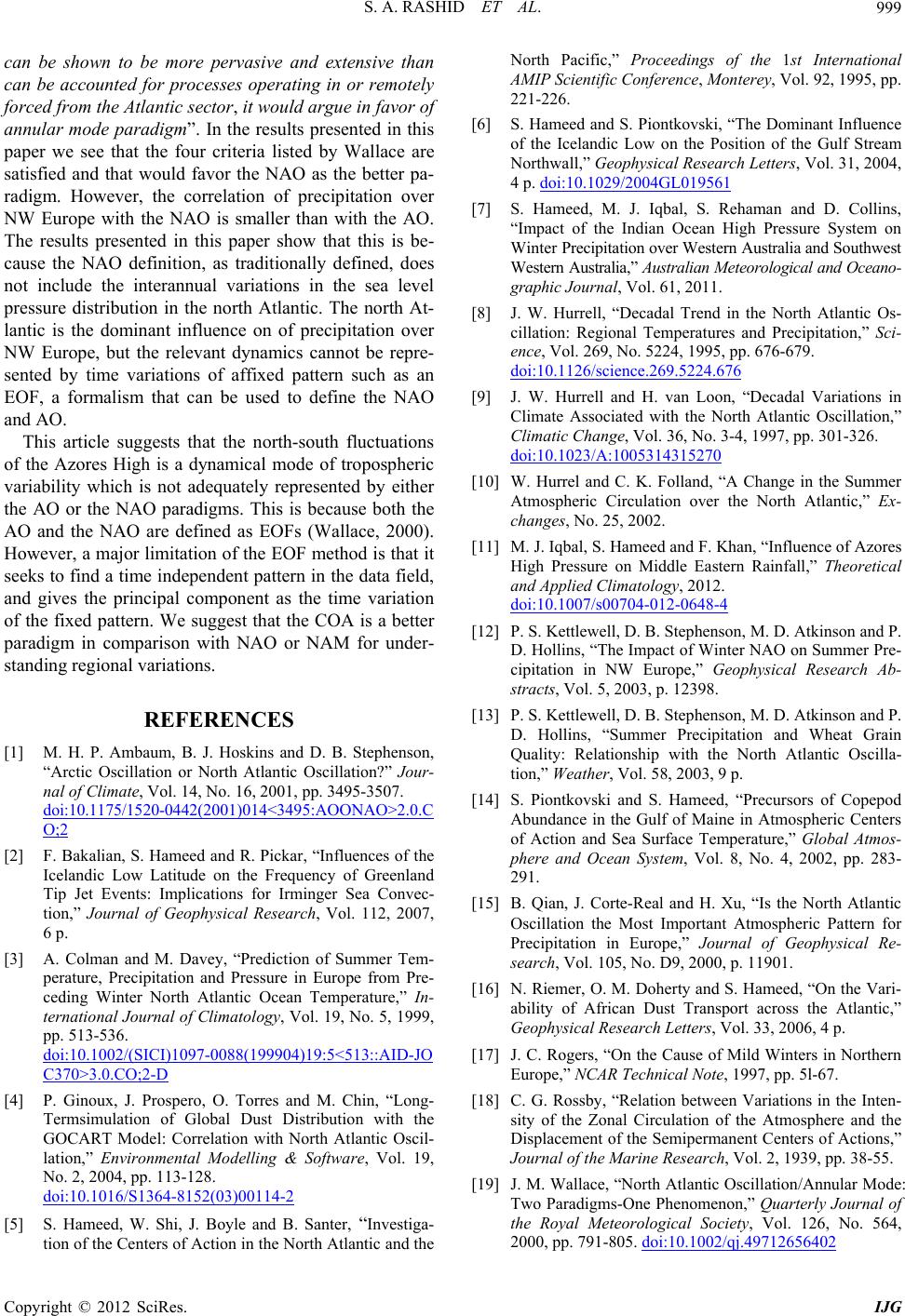
S. A. RASHID ET AL. 999
can be shown to be more pervasive and extensive than
can be accounted for processes operating in or remotely
forced from the Atlantic sector, it would argue in favor of
annular mode paradigm”. In the results presented in this
paper we see that the four criteria listed by Wallace are
satisfied and that would favor the NAO as the better pa-
radigm. However, the correlation of precipitation over
NW Europe with the NAO is smaller than with the AO.
The results presented in this paper show that this is be-
cause the NAO definition, as traditionally defined, does
not include the interannual variations in the sea level
pressure distribution in the north Atlantic. The north At-
lantic is the dominant influence on of precipitation over
NW Europe, but the relevant dynamics cannot be repre-
sented by time variations of affixed pattern such as an
EOF, a formalism that can be used to define the NAO
and AO.
This article suggests that the north-south fluctuations
of the Azores High is a dynamical mode of tropospheric
variability which is not adequately represented by either
the AO or the NAO paradigms. This is because both the
AO and the NAO are defined as EOFs (Wallace, 2000).
However, a major limitation of the EOF method is that it
seeks to find a time independent pattern in the data field,
and gives the principal component as the time variation
of the fixed pattern. We suggest that the COA is a better
paradigm in comparison with NAO or NAM for under-
standing regional variations.
REFERENCES
[1] M. H. P. Ambaum, B. J. Hoskins and D. B. Stephenson,
“Arctic Oscillation or North Atlantic Oscillation?” Jour-
nal of Climate, Vol. 14, No. 16, 2001, pp. 3495-3507.
doi:10.1175/1520-0442(2001)014<3495:AOONAO>2.0.C
O;2
[2] F. Bakalian, S. Hameed and R. Pickar, “Influences of the
Icelandic Low Latitude on the Frequency of Greenland
Tip Jet Events: Implications for Irminger Sea Convec-
tion,” Journal of Geophysical Research, Vol. 112, 2007,
6 p.
[3] A. Colman and M. Davey, “Prediction of Summer Tem-
perature, Precipitation and Pressure in Europe from Pre-
ceding Winter North Atlantic Ocean Temperature,” In-
ternational Journal of Climatology, Vol. 19, No. 5, 1999,
pp. 513-536.
doi:10.1002/(SICI)1097-0088(199904)19:5<513::AID-JO
C370>3.0.CO;2-D
[4] P. Ginoux, J. Prospero, O. Torres and M. Chin, “Long-
Termsimulation of Global Dust Distribution with the
GOCART Model: Correlation with North Atlantic Oscil-
lation,” Environmental Modelling & Software, Vol. 19,
No. 2, 2004, pp. 113-128.
doi:10.1016/S1364-8152(03)00114-2
[5] S. Hameed, W. Shi, J. Boyle and B. Santer, “Investiga-
tion of the Centers of Action in the North Atlantic and the
North Pacific,” Proceedings of the 1st International
AMIP Scientific Conference, Monterey, Vol. 92, 1995, pp.
221-226.
[6] S. Hameed and S. Piontkovski, “The Dominant Influence
of the Icelandic Low on the Position of the Gulf Stream
Northwall,” Geophysical Research Letters, Vol. 31, 2004,
4 p. doi:10.1029/2004GL019561
[7] S. Hameed, M. J. Iqbal, S. Rehaman and D. Collins,
“Impact of the Indian Ocean High Pressure System on
Winter Precipitation over Western Australia and Southwest
Western Australia,” Australian Meteorological and Oceano-
graphic Journal, Vol. 61, 2011.
[8] J. W. Hurrell, “Decadal Trend in the North Atlantic Os-
cillation: Regional Temperatures and Precipitation,” Sci-
ence, Vol. 269, No. 5224, 1995, pp. 676-679.
doi:10.1126/science.269.5224.676
[9] J. W. Hurrell and H. van Loon, “Decadal Variations in
Climate Associated with the North Atlantic Oscillation,”
Climatic Change, Vol. 36, No. 3-4, 1997, pp. 301-326.
doi:10.1023/A:1005314315270
[10] W. Hurrel and C. K. Folland, “A Change in the Summer
Atmospheric Circulation over the North Atlantic,” Ex-
changes, No. 25, 2002.
[11] M. J. Iqbal, S. Hameed and F. Khan, “Influence of Azores
High Pressure on Middle Eastern Rainfall,” Theoretical
and Applied Climatology, 2012.
doi:10.1007/s00704-012-0648-4
[12] P. S. Kettlewell, D. B. Stephenson, M. D. Atkinson and P.
D. Hollins, “The Impact of Winter NAO on Summer Pre-
cipitation in NW Europe,” Geophysical Research Ab-
stracts, Vol. 5, 2003, p. 12398.
[13] P. S. Kettlewell, D. B. Stephenson, M. D. Atkinson and P.
D. Hollins, “Summer Precipitation and Wheat Grain
Quality: Relationship with the North Atlantic Oscilla-
tion,” Weather, Vol. 58, 2003, 9 p.
[14] S. Piontkovski and S. Hameed, “Precursors of Copepod
Abundance in the Gulf of Maine in Atmospheric Centers
of Action and Sea Surface Temperature,” Global Atmos-
phere and Ocean System, Vol. 8, No. 4, 2002, pp. 283-
291.
[15] B. Qian, J. Corte-Real and H. Xu, “Is the North Atlantic
Oscillation the Most Important Atmospheric Pattern for
Precipitation in Europe,” Journal of Geophysical Re-
search, Vol. 105, No. D9, 2000, p. 11901.
[16] N. Riemer, O. M. Doherty and S. Hameed, “On the Vari-
ability of African Dust Transport across the Atlantic,”
Geophysical Research Letters, Vol. 33, 2006, 4 p.
[17] J. C. Rogers, “On the Cause of Mild Winters in Northern
Europe,” NCAR Technical Note, 1997, pp. 5l-67.
[18] C. G. Rossby, “Relation between Variations in the Inten-
sity of the Zonal Circulation of the Atmosphere and the
Displacement of the Semipermanent Centers of Actions,”
Journal of the Marine Research, Vol. 2, 1939, pp. 38-55.
[19] J. M. Wallace, “North Atlantic Oscillation/Annular Mode:
Two Paradigms-One Phenomenon,” Quarterly Journal of
the Royal Meteorological Society, Vol. 126, No. 564,
2000, pp. 791-805. doi:10.1002/qj.49712656402
Copyright © 2012 SciRes. IJG